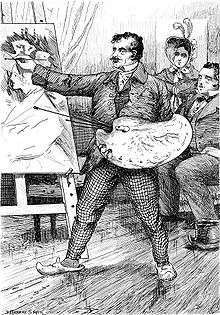Pierre Grassou
 Illustration of Honoré de Balzac's Pierre Grassou (1839) | |
| Author | Honoré de Balzac |
|---|---|
| Country | France |
| Language | French |
| Series | La Comédie humaine |
| Genre | Fiction |
Publication date | 1839 |
| Media type | |
Pierre Grassou is an 1839 short story by French author Honoré de Balzac (1799-1850) and included in the Scènes de la vie privee section of his novel sequence La Comédie humaine.[1]
Plot
Pierre Grassou de Fougères is a mediocre painter who lives off painting forgeries commissioned by an old swindler and art-dealer named Elias Magus. Grassou paints forgeries of works by Titian, Rembrandt, and other famous artists. Magus resells these forgeries for a large profit to members of the Petite bourgeoisie who are incapable of appreciating good art.
Monsieur Vervelle, a prosperous bottle-dealer obsessed with art, is introduced to Grassou by Magus, who introduces the painter as a grand master. Vervelle and his wife are enchanted with Grassou and believe he would make a good match for their daughter Virginie.
Grassou is invited to Ville-d'Avray, where the Vervelle mansion is garishly decorated, and also includes a large collection of Grassou’s work, including the forgery of a Titian. Grassou recognizes his own mediocrity, but when it is discovered by the Vervelles that the forgeries in their home were painted by Grassou, “far from denting his reputation, multiples Grassou’s value as an artist”[2] and as a son-in-law, since Vervelle believes Grassou to possess all the combined talent of Rubens, Rembrandt, Terburg, and Titian.
Despite his advantageous marriage, Grassou remains bitter that he is not a true artist. “This painter, a good father and a good husband, is unable to eradicate from his heart a fatal thought, namely, that artists laugh at his work; that his name is a term of contempt in the studios; and that the feuilletons take no notice of his pictures. But he still works on; he aims for the Academy, where, undoubtedly, he will enter."[3]
Themes
Sylvia Raphael wrote that the story "... contains amusing caricature of the bourgeois attitude to art, a good-natured portrait of the mediocre but financially successful painter, and a dig at the crafty trickery of the art dealer who trades on the vanity of the bourgeois, and the financial need of the artist."[4]
Bibliography
- Raphael, Sylvia. "Introduction". Honoré de Balzac: Selected Short Stories. Penguin Classics, 1977.
| Wikisource has original text related to this article: |
References
- ↑ Honoré de Balzac. "The Human Comedy: Introductions and Appendix". Project Gutenberg. Retrieved 16 April 2018.
- ↑ Diana Knight, Balzac and the model of painting: artist stories in La Comédie humaine. Volume 24 of Research monographs in French studies (MHRA, 2007), 102.
- ↑ de Balzac, Honoré.

- ↑ Raphael, Sylvia. "Introduction". Honoré de Balzac: Selected Short Stories. Penguin Classics, 1977.